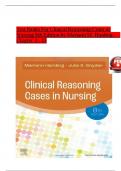Exam (elaborations)
TEST BANK For Clinical Reasoning Cases in Nursing 8th Edition, 2024 by Mariann M. Harding, Verified Chapters 1 - 15, Complete A+ Guide
TEST BANK For Clinical Reasoning Cases in Nursing 8th Edition, 2024 by Mariann M. Harding, Verified Chapters 1 - 15, Complete A+ Guide
[Show more]



